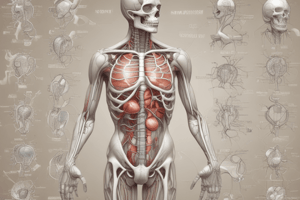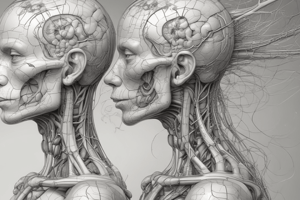Podcast
Questions and Answers
Flashcards
What is Anatomy?
What is Anatomy?
The study of the structure of the human body and its parts.
What is Gross Anatomy?
What is Gross Anatomy?
A branch of anatomy that focuses on structures visible to the naked eye.
What is Embryology?
What is Embryology?
The branch of anatomy dealing with the development of the human body from the fertilized egg to adulthood.
What is the Coronal (Frontal) Plane?
What is the Coronal (Frontal) Plane?
Signup and view all the flashcards
What is Flexion?
What is Flexion?
Signup and view all the flashcards
What is Extension?
What is Extension?
Signup and view all the flashcards
What is Rotation?
What is Rotation?
Signup and view all the flashcards
What is Elastic Cartilage?
What is Elastic Cartilage?
Signup and view all the flashcards
What is Hyaline Cartilage?
What is Hyaline Cartilage?
Signup and view all the flashcards
What is Fibrocartilage?
What is Fibrocartilage?
Signup and view all the flashcards
What is a Flat Bone?
What is a Flat Bone?
Signup and view all the flashcards
What is Endochondral Ossification?
What is Endochondral Ossification?
Signup and view all the flashcards
What is the Epiphyseal Plate?
What is the Epiphyseal Plate?
Signup and view all the flashcards
What is Intramembranous Ossification?
What is Intramembranous Ossification?
Signup and view all the flashcards
What is Skeletal Muscle?
What is Skeletal Muscle?
Signup and view all the flashcards
What is Cardiac Muscle?
What is Cardiac Muscle?
Signup and view all the flashcards
What is Smooth Muscle?
What is Smooth Muscle?
Signup and view all the flashcards
What is Endomysium?
What is Endomysium?
Signup and view all the flashcards
What is a Synovial Joint?
What is a Synovial Joint?
Signup and view all the flashcards
What is a Fibrous Joint?
What is a Fibrous Joint?
Signup and view all the flashcards
What is a Symphysis?
What is a Symphysis?
Signup and view all the flashcards
What is a Synchondrosis?
What is a Synchondrosis?
Signup and view all the flashcards
What is Flexion?
What is Flexion?
Signup and view all the flashcards
What is Extension?
What is Extension?
Signup and view all the flashcards
What is Abduction?
What is Abduction?
Signup and view all the flashcards
What is Adduction?
What is Adduction?
Signup and view all the flashcards
What is the Supine Position?
What is the Supine Position?
Signup and view all the flashcards
What is a Pivot Joint?
What is a Pivot Joint?
Signup and view all the flashcards
What is a Condyloid Joint?
What is a Condyloid Joint?
Signup and view all the flashcards
What is Endochondral Ossification?
What is Endochondral Ossification?
Signup and view all the flashcards
What is Intramembranous Ossification?
What is Intramembranous Ossification?
Signup and view all the flashcards
What is Bone?
What is Bone?
Signup and view all the flashcards
What is an Osteoblast?
What is an Osteoblast?
Signup and view all the flashcards
What is an Osteoclast?
What is an Osteoclast?
Signup and view all the flashcards
Study Notes
Anatomy and Physiology Study Notes
- Anatomy: The study of the structure of the human body.
- Branches of anatomy:
- Gross Anatomy: Studies structures visible to the naked eye.
- Microscopic Anatomy: Studies structures requiring a microscope.
- Developmental Anatomy: Studies the changes that occur as an organism develops.
- Radiological Anatomy: Uses imaging techniques (like X-rays and MRI) to study structures.
- Embryology: Studies the development of organisms.
- Pharmacology: The study of medications and their effects on the body/ not a branch of anatomy
- Clinical Scenario: A radiologist uses X-rays to observe chest structures.
- Radiological anatomy is the relevant branch.
- Planes of the body:
- Sagittal: Divides the body into anterior and posterior sections.
- Frontal (Coronal): Divides the body into anterior and posterior sections.
- Transverse: Divides the body into superior and inferior sections.
- Oblique: Divides the body in any angle other than the above.
- Movement in the sagittal plane:
- Lateral bending of the head/neck.
- Types of cartilage:
- Hyaline: Found in the trachea, nasal septum, articular surfaces of bones (except external ears)
- Elastic: Found in the external ear
- Fibrocartilage: Found in intervertebral discs
- Calcified cartilage: Not a type of cartilage. This describes a calcified form of cartilage.
- Flat bones:
- The Sternum is a flat bone.
- Endochondral ossification: Primarily occurs in long bones.
- Growth plate: The epiphyseal plate is the part of a long bone affected in a child with a fracture.
- Skeletal vs. Smooth muscles: Skeletal muscles are striated and voluntary, while smooth muscles are non-striated and involuntary.
- Connective tissue layer surrounding a muscle fiber: Endomysium
- Muscle architecture:
- Fusiform: Spindle-shaped.
- Parallel: Fibers run parallel to each other.
- Pennate: Fibers are oblique to the tendon.
- Types of synovial joints: Knee joint, skull sutures (not synovial joints), intervertebral discs (not synovial joints).
- Functional classification of joints: Synarthroses (immovable), amphiarthroses (slightly movable), diarthroses (freely movable).
- Type of joint affected in shoulder dislocation: Ball and socket joint
- Primary blood pressure regulator: Arterioles (small arteries)
- Blood flow in pulmonary circulation: Heart → lungs → heart
- Which branch of anatomy is gross anatomy: Gross anatomy
- Soft tissue imaging: MRI or Ultrasound
- Understanding the spatial relationships between organs: Topographical anatomy
- Movement away from midline: Abduction
- Lying on back with face upwards: Supine position.
- Plane of movement affected in dorsiflexion difficulty: Sagittal plane
- Cartilage that lacks perichondrium: Fibrocartilage
- Primary function of fibrocartilage: Absorb shock.
- Structure affected in epiglottis damage: Ability to swallow. Or breathing.
- Irregular bone: Vertebra is an irregular bone
- Intramembranous ossification location: Clavicle, skull
- Newborn with abnormal cranial development: Endochondral ossification
- Intercalated discs structure: Cardiac muscle
- Type of joint with most movement: Synovial joint
- Example of a pivot joint: Atlantoaxial joint
- Type of joint affected in knee injury (traumatic): Synovial joint
- Thickest muscular wall vessel: Arteries
- Structure in synovial joint affected by cartilage damage: Articular cartilage
- Bone growth in length: Epiphyseal plate
- Endochondral ossification location: Long bones, not flat bones or irregular bones.
- Which part of a long bone is responsible for growth in length?: Epiphyseal plate
- Cartilage in intervertebral discs: Fibrocartilage
- Cartilage in auricle: Elastic cartilage
- Type of cartilage in articular cartilage: Hyaline cartilage
Additional Notes
- Clinical Scenarios: Use these to practice applying anatomical concepts to real-world situations.
- Definitions: Understand the meanings of key terms.
- Relationships: Recognize the connections between different structures and systems in the body.
Studying That Suits You
Use AI to generate personalized quizzes and flashcards to suit your learning preferences.




